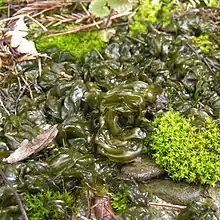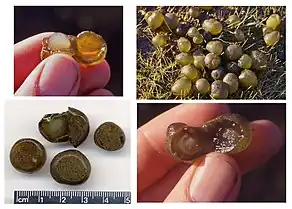Nostoc
| Nostoc | |
|---|---|
 | |
| Nostoc commune | |
| Scientific classification | |
| Domain: | Bacteria |
| Phylum: | Cyanobacteria |
| Class: | Cyanophyceae |
| Order: | Nostocales |
| Family: | Nostocaceae |
| Genus: | Nostoc Vaucher, 1888, ex Bornet and Flahaul |
| Species | |
|
List
| |
Nostoc, also known as star jelly, troll’s butter, witch's butter (not to be confused with witches' butter), and witch’s jelly, is a genus of cyanobacteria found in various environments that forms colonies composed of filaments of moniliform cells in a gelatinous sheath.
The name Nostoc was coined by Paracelsus.[1]
Nostoc can be found in soil, on moist rocks, at the bottom of lakes and springs (both fresh- and saltwater), and rarely in marine habitats. It may also grow symbiotically within the tissues of plants, providing nitrogen to its host through the action of terminally differentiated cells known as heterocysts. These bacteria contain photosynthetic pigments in their cytoplasm to perform photosynthesis.
Species
Nostoc is a member of the family Nostocaceae of the order Nostocales. Species include (see collapsed list on the right for full listing) :
- Nostoc azollae
- Nostoc caeruleum Lyngbye ex Bornet et Flahault[2]
- Nostoc carneum
- Nostoc comminutum
- Nostoc commune (Linnaeus) Vaucher ex Bornet et Flahault[2] (Chinese: Koxianmi)[3]
- Nostoc ellipsosporum
- Nostoc flagelliforme
- Nostoc linckia
- Nostoc longstaffi
- Nostoc microscopicum (Carmichael ex Harvey) Bornet et Flahault[2]
- Nostoc muscorum
- Nostoc paludosum
- Nostoc pruniforme (Linnaeus) C. A. Agardh ex Bornet et Flahault[2]
- Nostoc punctiforme
- Nostoc sphaericum
- Nostoc sphaeroides
- Nostoc spongiaeforme
- Nostoc thermotolerans
- Nostoc verrucosum Vaucher ex Bornet et Flahault[2]
Nonscientific nomenclature
When it is on the ground, a Nostoc colony is ordinarily not seen, but after a rain, it swells up into a conspicuous, jellylike mass, which was once thought to have fallen from the sky, hence the popular names, star jelly, troll’s butter, witch's butter (not to be confused with the fungus Tremella mesenterica), and witch’s jelly.
Culinary use
Containing protein and vitamin C,[4] Nostoc species are cultivated and consumed as a foodstuff, primarily in Asia. The species N. flagelliforme and N. commune are consumed in China, where it was used to survive famines. The preferred variety in Central Asia is N. ellipsosporum.
References
Citations
- ↑ Potts, M. (1997). "Etymology of the Genus Name Nostoc (Cyanobacteria)" (PDF). International Journal of Systematic Bacteriology. 47 (2): 584. doi:10.1099/00207713-47-2-584. Archived (PDF) from the original on 2013-08-11. Retrieved 2011-11-05.
- 1 2 3 4 5 Mollenhauer, Dieter; Bengtsson, Roland; Lindstrøm, Eli-Anne (1999). "Macroscopic cyanobacteria of the genus Nostoc: a neglected and endangered constituent of European inland aquatic biodiversity". European Journal of Phycology. 34 (4): 349–360. doi:10.1080/09670269910001736412.
- ↑ Abbott, I. A. (1989). "Food and food products from seaweeds". In Lembi, C. A.; Waaland, J. R. (eds.). Algae and human affairs. Cambridge University Press, Phycological Society of America. p. 141. ISBN 978-0-521-32115-0.
- ↑ Deane, Green (2011-08-31). "Nostoc Num Nums". Eat The Weeds and other things, too. Archived from the original on 2019-01-31. Retrieved 2019-02-20.
General sources
- "Nikon MicroscopyU: Confocal Image Gallery - Nostoc (Cyanobacteria)". 9 March 2005. Archived from the original on 2005-03-09. Retrieved 15 January 2019.
- Office, NOAA Sea Grant Extension. "GLERL/Sea Grant: Great Lakes Water Life Photo Gallery - Blue-green Algae - Cyanophtya". www.glerl.noaa.gov. Archived from the original on 2019-02-20. Retrieved 2019-02-20.
- Davidson, Alan. Oxford Companion to Food (1999), "Nostoc". ISBN 0-19-211579-0
External links
- "Aktuelle News, Schlagzeilen und Berichte aus aller Welt - Arcor.de". www.arcor.de. Retrieved 15 January 2019. Nostoc spec. in lichens
- Guiry, M.D.; Guiry, G.M. "Nostoc". AlgaeBase. World-wide electronic publication, National University of Ireland, Galway.
